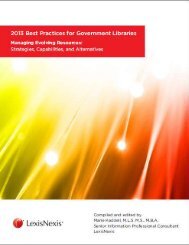2012 Best Practices for Government Libraries
2012 Best Practices for Government Libraries
2012 Best Practices for Government Libraries
Create successful ePaper yourself
Turn your PDF publications into a flip-book with our unique Google optimized e-Paper software.
Conversational Patterns That Support Telling Truth to Power<br />
By Nancy M. Dixon, Principal Researcher, Common Knowledge Associates<br />
Originally published on January 27, <strong>2012</strong> in Conversation Matters<br />
116<br />
BEST PRACTICES <strong>2012</strong><br />
The Defense Intelligence Agency’s (DIA) Knowledge Lab faced the challenge of how<br />
to move accurate intelligence up the chain of command. Too frequently the<br />
intelligence analysis, painstakingly generated by front line analysts, was delayed<br />
and often severely modified by a chain of superiors be<strong>for</strong>e it reached policy makers<br />
who could act upon it.<br />
Zeke Wolfberg, the Director of the Knowledge Lab and I, as the knowledge<br />
management consultant to the Knowledge Lab, recently published an article about<br />
how we addressed that problem at DIA. The article appeared in Reflections, the<br />
SOL Journal on Knowledge, Learning and Change (Vol. 10, 4). I provide a summary<br />
of the article in this post. The full article can be downloaded under My Publications<br />
on the left.<br />
DIA provides military intelligence to prevent strategic surprise and deliver a<br />
decision advantage to warfighters, defense planners, and policymakers. The<br />
analysts who develop intelligence assessments are divided into teams of 30 plus<br />
with each team focused on a different region (e.g. South East Asia) or a different<br />
functional area (e.g. missiles), as well as task <strong>for</strong>ces that are periodically assembled<br />
to address crises (e.g. the Mumbai terrorist attack).<br />
The intervention we undertook to enable telling truth to power, was called “Critical<br />
Discourse.” The <strong>for</strong>mat was to bring together a team of analysts along with their<br />
supervisor, to jointly analyze the actual conversations that occurred between<br />
members of the team and between team members and their supervisor. The<br />
conversation analysis was based on the work Chris Argyris, using his left and right<br />
hand case <strong>for</strong>mat to create scripts of difficult past conversations. Each analyst and<br />
supervisor selected and wrote out the dialogue that occurred in three difficult<br />
conversations they had engaged in. Each team met over a period of three months<br />
to analyze each other’s cases and to practice Argyris’ Model II skill set with the goal<br />
of reducing the misunderstandings occurring in their conversations. Each team<br />
member also received individual coaching between group meetings.<br />
Model II is a way of interacting that results in knowledge and learning <strong>for</strong> everyone<br />
who is engaged in the conversation. The goal of Model II interaction is not to win an<br />
argument, but to create a space <strong>for</strong> joint learning. A person using the Model II skill<br />
set holds in their mind the underlying assumption that, “I have part of the<br />
in<strong>for</strong>mation and others have other parts that I may not be aware of.” The skills are<br />
used to get all the in<strong>for</strong>mation that is available and pertinent into the conversation.



